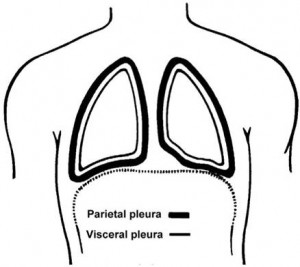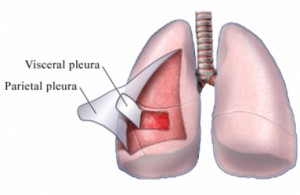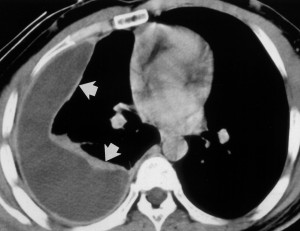Parietal pleura Definition
It is the outermost of the pleural membranes, which are two in number, and forms a lining for the chest cavity that contains the lungs.
In Latin, this organ is known as “Pleura Parietalis”.
Parietal pleura Location
It is affixed to the wall of the thoracic cavity and covers the superior diaphragm surface. The endothoracic fascia joins it to the inner side of the thoracic cavity.
Picture 1 – Parietal pleura
Parietal pleura Function
It covers the diaphragm and lines the inner walls of the chest. This structure is a serous membrane and produces a type of serous fluid referred to as Pleural fluid. The fluid helps the surfaces of the visceral and parietal pleura easily glide over each other when the lungs dilate and contract during respiration.
Parietal pleura Types
Based on the area that it covers on either side of the thorax, this structure is classified into various types:
- Costal pleura: This part of parietal pleura provides cover to the inner portion of the rib, intercostals muscles, and costal cartilages.
- Mediastinal pleura: This part of the parietal pleura covers the lateral space of the mediastinum, which is the central component constituting the thoracic cavity while containing multiple organs.
- Cervical pleura: It offers subsequent lining to the extension of the pleural cavity into the neck.
- Diaphragmatic pleura: It covers the superior portion of the thoracic surface of the diaphragm.
The joints of these areas are considered to be the sites of pleural reflection.
Parietal pleura Description
The phrenic and the intercostals nerves innervate the Parietal pleura. It isolates the pleural cavity from the mediastintum. This physical structure comprises of a thin basal layer of fibrous tissue that is covered by a uniform layer of mesothelial cells. These cells secrete a lubricating substance that lines the pleural cavity.
The costal segment of the parietal pleura acts as a lining for the inner slope of the ribs and intercostal muscles located within them. It is the endothoracic fascia that separates it from these structures. The intercostal nerves innervated this section. The phrenic nerve innervates the diaphragmatic section of the parietal pleura which lies over the diaphragm. It also caters to the mediastinal portion of the parietal pleura which forms the lateral mediastinum wall.
Neurovascular Supply
Unlike visceral pleura, its parietal counterpart is quite sensitive to pain, temperature, and pressure. The pain produced in the portion if well localised and is normally innervated in the intercostal nerves and the phrenic nerve system. The pleura receive blood supply from the intercostals arteries.
Pleura Cavity
This is the potential space created between both the pleura i.e. visceral pleura and parietal pleura. Space is filled with serous fluid that performs two vital functions. These include
- The cavity lubricates the pleural surface, thereby letting them slide over each other
- The fluid in the space develops surface tension that pulls both the pleura together, ensuring when the thorax undergoes expansion, the lungs also get expand accordingly by getting filled with air
Parietal pleura Clinical Significance
Whether it is the visceral pleura or parietal pleura, pneumothorax is the serious condition that arises affecting both of them. It is commonly referred to as the collapsed lung condition. It arises when the air or gas fills the pleural space. The lung extension gets reduced as the air or gas filling the space leads to the reduction of the surface tension o the serous fluid.
Parietal pleura Symptoms
- Chest pain
- Shortness of breath
- Asymmetrical chest expansion
Pneumothorax can occur in two forms – Spontaneous and traumatic. The first one does not occur because of a specific cause. It can be primary and secondary. While the primary one does not signify the presence of any underlying respiratory disorder, the secondary does imply the presence of the same.
On the other hand, the traumatic form of the condition occurs due to the blunt or penetrating chest trauma, including rib fracture.
Parietal pleura Pictures
Here are some carefully selected images of Parietal pleura that you may find quite useful for reference.
Picture 2 – Parietal pleura Image
Picture 3 – Enhancing Parietal pleura
References:
http://www.anatomy-class.com/the-pleura-and-airways.html
http://www.gpnotebook.co.uk/simplepage.cfm?ID=-1288372165
http://www.wisegeek.com/what-is-the-parietal-pleura.htm




No comments yet.